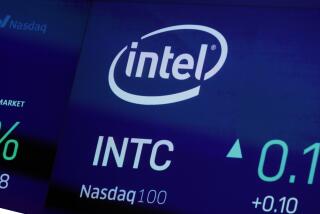Chip Makers’ Outlook Dismal for Early ’01
- Share via
SAN FRANCISCO — It’s been anything but merry for semiconductor stocks in the second half of this year, and the industry looks set for some pretty rough sledding for the first quarter of 2001.
Disappointing holiday sales of personal computers, too much inventory among mobile phone makers and a slowing global economy conspired to make the second half of 2000 dismal. Most chip stocks are down more than 60% from their year highs.
Because of slack PC sales, many analysts believe Intel Corp. and its rival Advanced Micro Devices Inc. are saddled with excess inventory of microprocessors and fear that if they dump the chips in the market--instead of writing them off--it would be disastrous. Outside the PC industry, though, other chip companies are nearly finished working off excess inventory and should be in a better position next year. Demand, analysts say, still looks pretty good overall.
“This, of course, all precludes a recession,” said SG Cowen & Co. semiconductor analyst Drew Peck. “If the economy falls apart, then all bets are off on any of these semiconductor companies. But short of a significant recession, the rest of the industry is actually reasonably well-positioned because demand looks pretty good.”
That said, it’s been a rough several months for chip makers. Among the semiconductor companies that issued profit warnings for the fourth quarter are: Altera Corp., Cypress Semiconductor Corp., Intel, Lattice Semiconductor Corp., LSI Logic Corp., National Semiconductor Corp. and Xilinx Inc. “Semiconductor companies are rapidly reducing capital-spending plans in response to higher inventories and weaker demand,” wrote Salomon Smith Barney analyst Jonathan Joseph in a recent report. “Intel is the latest example of that, with plans to push out a microprocessor [plant] expansion in Ireland and Flash [memory chip] push-outs in Colorado and New Mexico.”
Others have already joined the chorus. Samsung Electronics, the world’s biggest maker of dynamic random-access memory, or DRAM, chips, had said 2001 investment would be similar to the 2000 level of $5.9 billion. But company spokesman James Chung said in November, “We see a possibility of reducing our planned investment for next year. We’ve become more conservative in dealing with a changing industry.”
Another, Micron Technology Inc., one of the biggest makers of memory chips for PCs, on Dec. 20 said it believed memory-chip makers will spend at a slower rate in 2001. Thomas Weisel Partners analyst Eric Ross in a report revised capital-spending estimates downward from a 40% increase to “20% and subsequently to flat based on various negative indicators within the industry.”
The rather grim outlook comes as the chip industry recovered from its worst-ever slump last year. For 2000, sales are forecast to rise a robust 37% to a record $205 billion, according to the Semiconductor Industry Assn., led by chips for data networking, broadband, wireless and optical-fiber communication systems.
Growth for next year was initially pegged at 20%, with worldwide sales of semiconductors rising to $249 billion, but now analysts say that might be too optimistic.
“Due to slower economic growth and an inventory correction, the semiconductor industry has experienced a significant deterioration in overall fundamentals,” said Morgan Stanley Dean Witter semiconductor analyst Mark Edelstone.
“Following peak year-over-year revenue growth of 52% in August, rates of change decelerated to 45% in September and 39% in October,” Edelstone wrote in a note. “Although the data will not be available until early February, we believe the growth rate will decelerate to the mid-20% level in December, with 10% growth likely by the middle of next year.”






